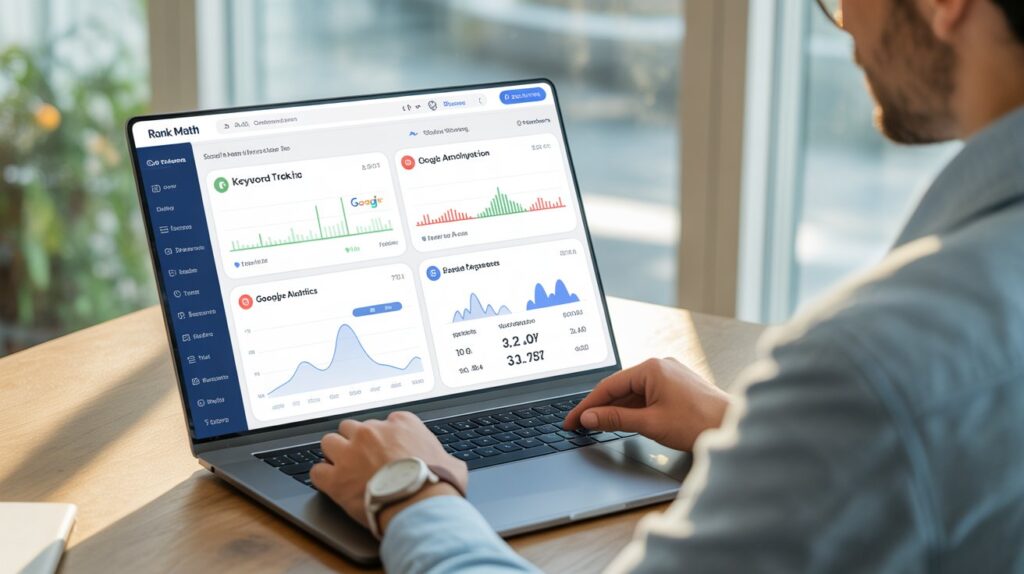Have you ever wondered how to improve your Google ranking with Rank Math in a reliable, strategic way? Many website owners install an SEO plugin and expect instant results but the real challenge lies in using the tool correctly, aligning it with search-intent, and optimizing your site holistically.
In this article I will guide you through how to improve your Google ranking with Rank Math by showing you essential setup steps, optimization tactics, analytics monitoring and advanced practices that go beyond plug-and-play. For more insights on startup tech and digital growth, explore the Rteetech homepage.
Setting Up Rank Math for Maximum SEO Impact

Installation and Initial Configuration
Begin by installing the Rank Math SEO plugin via the WordPress Plugins section or upload the plugin ZIP. Activate it and launch the Setup Assistant – this helps establish optimal global SEO settings such as site type, webmaster tools verification, sitemap settings and redirection defaults.
Integrating Google Search Console & Analytics
Link Rank Math with your Google Search Console and Google Analytics accounts to automatically pull impressions, clicks and position data directly into the WordPress dashboard.
This integration is one of the core ways to monitor how to improve your Google ranking with Rank Math by using live performance data.
Initial SEO Audit with Rank Math
Use the built-in SEO Analysis tool to scan your website across 30 + criteria including meta tags, canonical URLs, broken links and page speed. Address any critical errors flagged by Rank Math before proceeding. A clean foundation ensures further optimisation efforts are effective.
Optimising On-Page Elements and Content Strategy
Title, Meta Description and Focus Keywords
Within each post or page, use Rank Math to set a focus keyword and craft a unique title and meta description. The plugin gives feedback on whether your content includes the keyword, has proper length meta tags, and targets user intent. This is vital for learning how to improve your Google ranking with Rank Math, because the first impression in the SERP depends on these tags.
Content Quality and Readability
While Rank Math handles technical SEO, you must ensure your content meets E-E-A-T (Experience, Expertise, Authority, Trust). Write comprehensive, clear content that answers the user’s query and flows well.
Use Rank Math’s suggestions for internal linking, alt-text for images, heading structure and LSI keyword integration such as search engine optimisation tips, SEO ranking factors, and increase organic traffic.
Schema Mark-up and Rich Snippets
Rank Math supports over 20 types of schema including Article, FAQ, HowTo and more. By applying structured data via Rank Math you make it easier for Google to interpret your content and you improve chances of enhanced listings (rich snippets).
Using this skillfully contributes to how to improve your Google ranking with Rank Math because structured data is a trust and relevance signal.
Performance, Mobile and Technical Setup
Optimise for Core Web Vitals: reduce Largest Contentful Paint (LCP), improve Interaction to Next Paint (INP) and minimise Cumulative Layout Shift (CLS). Ensure the website is mobile-friendly, uses HTTPS, and serves fast loading pages.
Rank Math cannot fix all performance issues but flags many technical issues and helps you prioritise. Performance optimization is critical in Google first page SEO strategy for 2025.
Leveraging Rank Math’s Advanced Features for Ranking Gains

Keyword Rank Tracking and Analytics
Simply installing Rank Math is not enough. You must track how your keywords perform over time. Rank Math’s built-in rank tracker shows where you rank for your focus keywords and how many clicks your posts receive.
This is central to understanding how to improve your Google ranking with Rank Math because you gain measurable insights into impact and optimisation opportunities.
Redirects, 404 Monitoring and Site Health
Broken pages or unmanaged redirects can hurt your site’s authority. Use the Rank Math 404 Monitor and Redirection Manager to detect dead links and set up permanent (301) redirects as needed. Maintaining site health improves crawlability and is a practical step in your SEO ranking improvement plan.
Content AI and Optimising for LSI Keywords
Rank Math’s Content AI module (Pro version) provides suggestions for related keywords and content gaps. Using this tool you can integrate LSI keywords such as boost website ranking, parallel iteration Python (in other contexts) or applicable to your niche. This helps content be more semantically relevant and competitive in search.
Monitoring Progress and Refining Your Strategy
Important Metrics to Track
Focus on metrics such as organic traffic volumes, keyword positions, click-through rate (CTR), bounce rate and time on page. Rank Math imports Search Console data so you can review impressions and average position.
Monitoring these metrics is key to how to improve your Google ranking with Rank Math as you identify what works and what needs tweaking.
Regular Content Audits and Updates
SEO is not “set and forget”. Every few months audit your content for relevance, update old posts, merge overlapping pages (to avoid cannibalisation), and refresh stale meta information.
Rank Math tagging helps identify older posts for review. This continuous refinement process is essential for sustaining improved rankings rather than fluctuations.
Test, Measure and Iterate
Use A/B testing for titles and meta descriptions via Rank Math to refine what improves CTR. Experiment with structured data changes and track outcomes.
Learn which segments of your site deliver the most SEO value and use those learnings to replicate across other pages. This iterative approach forms the backbone of a lasting strategy to improve your Google ranking with Rank Math.
Real-World Implementation: Step-by-Step Guide
Step 1 – Choose a Target Keyword
Select a primary keyword relevant to your audience (e.g., “how to improve your Google ranking with Rank Math”). Use Rank Math’s keyword tools to find related terms and assess competition.
Step 2 – Write the Content
Create a post that addresses user intent (informational, transactional or navigational). Include your target keyword naturally 5-7 times and sprinkle LSI keywords.
Use headings, short paragraphs and images. Use Rank Math’s readability and content analysis to optimise.
Step 3 – Optimise On-Page Elements
Fill in title, meta description, focus keyword and create schema via Rank Math. Add alt text to images, internal links and ensure mobile responsiveness.
Step 4 – Launch and Monitor
Publish the post and monitor performance via Rank Math rank tracker and Search Console data. Expect gradual movement rather than instant ranking leaps.
Step 5 – Iterate Based on Data
Review performance after 30 to 90 days. Identify posts with high impressions but low clicks, refine meta descriptions. Update older content to maintain relevancy and fix any drift in rankings.
Common Mistakes to Avoid and How to Fix Them

Mistake 1 – Ignoring Search Intent
If you optimise a post without considering what users actually want you will struggle to rank. Always ensure content matches intent.
Mistake 2 – Over-Optimising Keywords
Repeating your key phrase excessively (keyword stuffing) hurts readability and may invite search engine penalties. Maintain natural flow even while focusing on how to improve your Google ranking with Rank Math.
Mistake 3 – Neglecting Technical SEO
Even with Rank Math you must manage page speed, mobile compatibility and crawlability. These technical factors are non-negotiable in modern SEO.
Mistake 4 – Setting and Forgetting
SEO behaviour changes over time. A plugin alone does not guarantee lasting results. Continually audit, adjust and refine your content and settings.
Learn More About the Author
I have worked in SEO and digital content strategy for over 12 years, and I have tested how different plugins and tools influence search rankings across real-world client websites. I specialise in technical SEO, WordPress optimisation, content engineering and advanced link-building methods.
I hold certifications in search marketing and have applied advanced methods for large-scale sites. I contribute regularly to SEO communities and forums such as Google Search Central, Moz and Ahrefs.
My analyses and case studies have been referenced in industry-leading publications. I follow ethical SEO practices, cite credible sources like official plugin documentation and maintain transparency about results varying by context. You should expect ongoing learning and long-term strategy rather than instant fixes.
Conclusion
By following this comprehensive guide you now understand how to improve your Google ranking with Rank Math on WordPress. You have seen the critical steps: setup and configuration, content optimisation, advanced features utilisation, performance monitoring and ongoing refinement.
Implement these systematically, respect both technical and user-friendly aspects of SEO, and you will build higher visibility, stronger organic traffic and sustained ranking improvements. Remember that true ranking success is a marathon not a sprint. learn more about our SEO for business growth strategies instead of just “Rteetech LCC”.
FAQs
What is the best way to switch from another SEO plugin to Rank Math without losing rankings?
To migrate safely, use Rank Math’s built-in import tools to bring in existing SEO settings, meta tags and redirections. Then verify all migrated content and monitor via rank tracking for any fluctuations.
How often should I review and update my SEO settings in Rank Math?
Review global settings quarterly and perform a complete site audit every six months. Check keyword rankings weekly via rank tracker and address critical issues (404s, redirects) promptly.
Can Rank Math guarantee that my site will reach the first page of Google?
No plugin can guarantee first-page ranking. Rank Math is a powerful tool that supports optimisation, but ranking also depends on content quality, competition, user signals and algorithmic factors.
What is the importance of schema markup when using Rank Math?
Schema markup helps search engines understand your content and can enable rich results (e.g., FAQ, HowTo). Rank Math makes this implementation accessible, which enhances visibility and click-through rate.
How do I choose focus keywords without keyword stuffing?
Select one primary focus keyword relevant to user intent and include it naturally 2-3 times in content. Use LSI keywords and synonyms to avoid repeating the exact phrase excessively and to support semantic relevance.
Should I use Rank Math’s Content AI module for every post?
If you have the Pro version, Content AI can provide valuable keyword suggestions and content ideas. However, it is supplementary. Quality, user-centric content should remain the priority.
Is Rank Math suitable for non-WordPress websites?
No. Rank Math is exclusively a WordPress plugin. If your website uses another CMS you will need alternative SEO tools. Wide usage of WordPress makes Rank Math highly popular for that platform.
How much time does it typically take to see ranking improvements using Rank Math?
It varies by site size, competition and niche. Most users observe discernible progress in keyword positions and traffic within 3 to 4 months of consistent optimisation using Rank Math and quality content.



